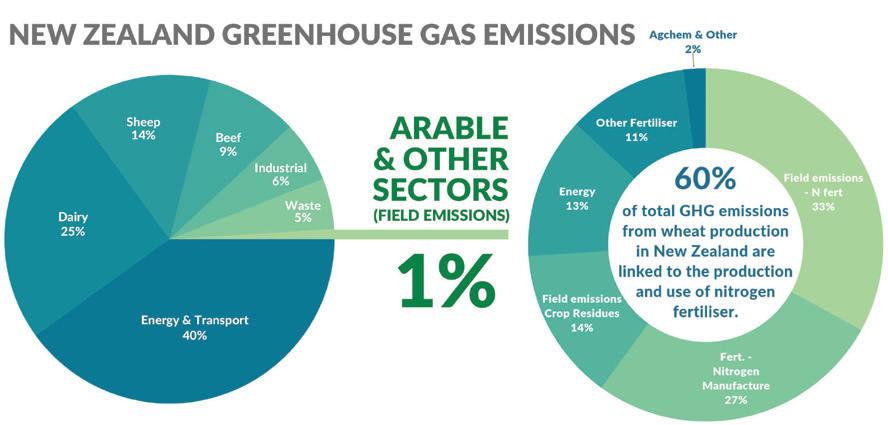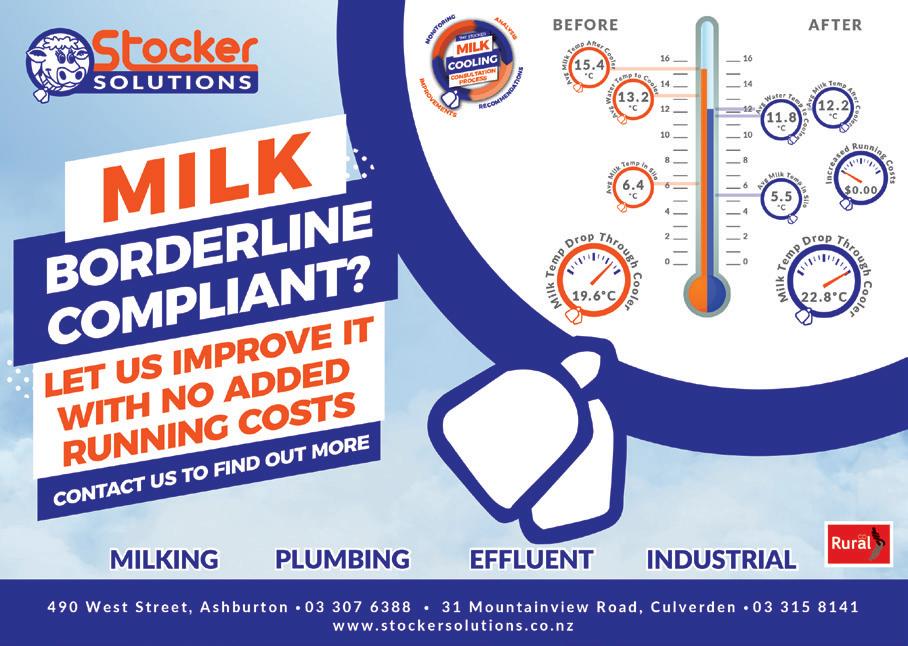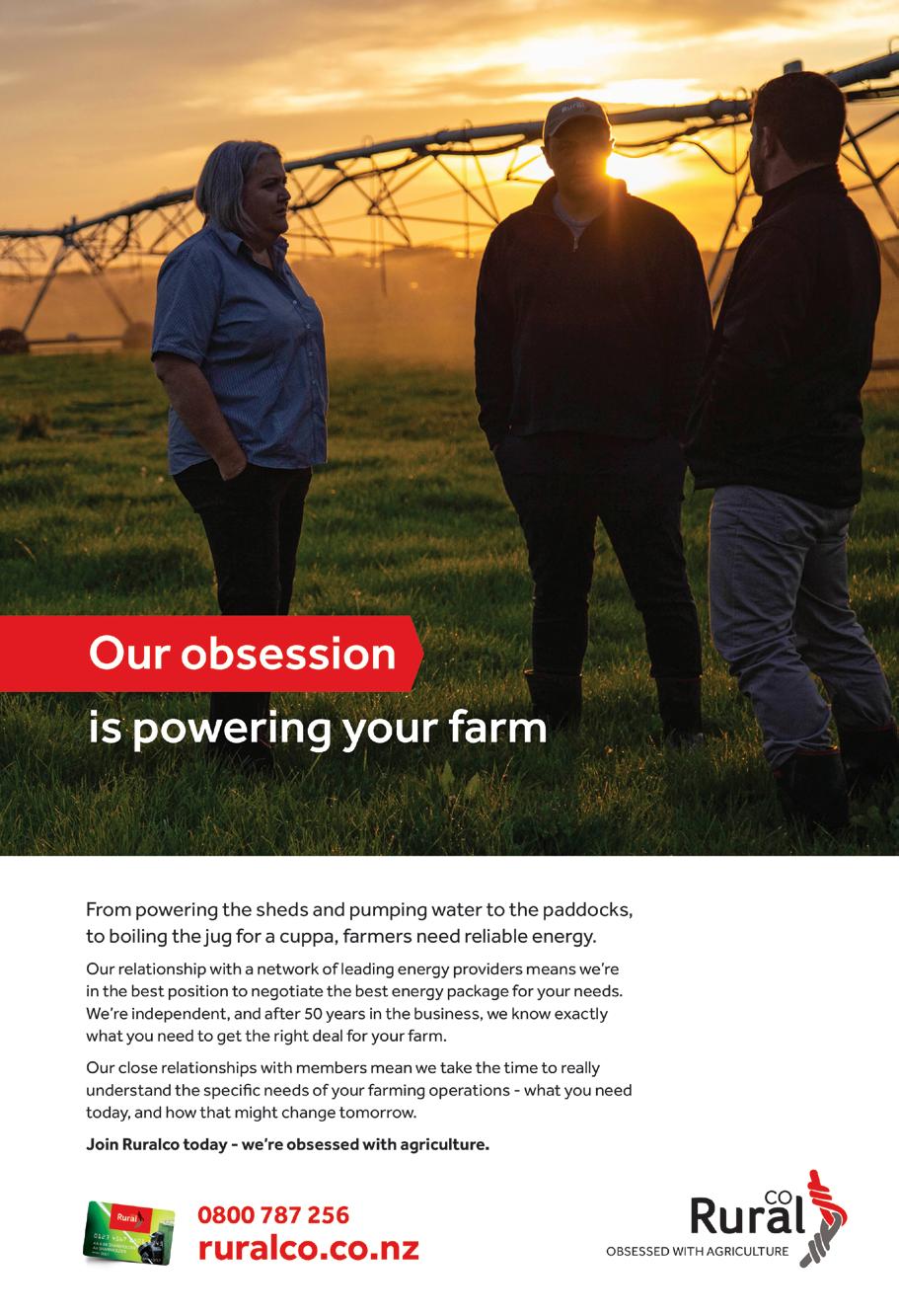
9 minute read
Agricultural greenhouse gas emissions
by Ruralco
Who needs to do what by when…(and how)?
WORDS SUPPLIED BY FAR
Advertisement
KEY POINTS
New Zealand has committed to reducing greenhouse gas emissions to 30% below 2005 levels by 2030 as part of the Paris Agreement.
Methane and nitrous oxide from farms make up about half of our national greenhouse gas profile.
Emissions are priced through the New Zealand Emissions Trading Scheme (NZ ETS). The ETS currently excludes agricultural emissions, which are yet to be priced.
A programme called He Waka Eke Noa has been developed to establish a relevant New Zealand response to climate change, including agricultural greenhouse gas emissions.
The process to date
Over the last 25 years, farmers have improved their production efficiency, and gas emissions per unit of product have reduced by about 1% each year. These improvements have helped stabilise methane and nitrous oxide emissions, but stabilisation is not enough; we need to find practical and cost-effective ways of reducing these emissions.
In May 2018, New Zealand’s Interim Climate
Change Committee (ICCC) began work to inform policies to help reduce agricultural greenhouse gases. Not surprisingly, they found there were no easy answers, but, on balance, they concluded that the best way to motivate all farmers to reduce emissions on their farms is by pricing them. The benefits of a pricing mechanism include: • Giving farmers autonomy to choose what actions to take on their farm • Rewarding those farmers who take positive actions and those who go the extra mile • Can be managed to ensure that emissions reduce in line with national targets 40 REAL FARMER • Likely to result in emission-reductions at the lowest cost to the sector. The ICCC also concluded that emissions from livestock should be priced at the farm-level, whereas emissions from nitrogen fertiliser should be priced at the fertiliser manufacturer and importer level. These ICCC recommendations went to the government, who, in consultation with the agricultural sectors and iwi, have developed a five-year programme to make sure an emissions pricing scheme is workable and effective. The programme is called He Waka Eke Noa (our future in our hands). He Waka Eke Noa He Waka Eke Noa combines industry, Māori and Government resources, expertise and knowledge in a partnership to support farmers and growers to adapt to climate change and measure, manage and reduce emissions from their farm. The partnership is working together to develop a framework, by 2025, to equip farmers and growers to measure, manage and reduce on-farm agricultural greenhouse gas emissions and adapt to climate change, to enable sustainable food and fibre production for future generations. The aim is that by 2025 all farmers and growers are i) including climate change mitigation and adaptation in their farm business and environment plans; ii) able to calculate their net greenhouse gas emissions and iii) incentivised to take action on climate change through an appropriate pricing mechanism for emissions. The partnership The Partnership will provide farmers and growers with a toolkit over the next five years, including: • guidance on how to manage and reduce on-farm agricultural emissions; • a farm plan module for planning the steps to be taken on the farm to reduce emissions; • a system for measuring and reporting on emissions;
a mechanism for pricing emissions as an incentive to take action; –guidance on increasing long-term carbon storage (for example in trees or soil); –guidance on adapting to a changing climate.
The partners are: Apiculture NZ, Beef + Lamb NZ, DairyNZ, DCANZ, Deer
Industry NZ, Federation of Māori
Authorities, Federated Farmers of
New Zealand, Foundation for Arable
Research, Horticulture NZ, Irrigation NZ,
Meat Industry Association, Ministry for
Primary Industries and Ministry for the
Environment. The work programme Many farmers and growers have already reduced emissions as they have increased their productivity, through steps such as having fewer but more profitable animals, managing fertiliser use more efficiently, and planting trees. He Waka Eke Noa aims to support farmers and growers to go further by measuring, managing and reducing emissions from their farm. To develop and deliver information, tools and support for farmers and growers, a number of workstreams have been set up to work on specific issues. Each workstream includes industry, Māori and government and will be calling for input from farmers and growers to ensure all perspectives are considered. The workstreams (June 2020) are: • Farm planning—developing Good Farming
Practice Principles for greenhouse gases and integrating with other environmental and farm business guidance and requirements. • Emissions reporting—developing criteria, methodologies and definitions for calculating on-farm emissions and a system for farmlevel emissions accounting and reporting. On-farm sequestration—Sequestration is the long- term storage of carbon, for example in trees or soil. This workstream is focussed on designing a simple and cost-effective mechanism that incentivises on-farm carbon sequestration from sources that do not currently qualify under the ETS.
These sources may include, but are not limited to, native vegetation, soil carbon, riparian planting, shelter belts, woodlots, orchards and vines.
Emissions pricing—design a farm level pricing mechanism that incentivises farmers and growers to reduce emissions.
This would be an alternative to the existing
Emissions Trading Scheme (ETS) pricing mechanism. • Māori agribusiness—a cross-connecting workstream that integrates Māori perspectives into He Waka Eke Noa to ensure relevance and delivery to Māori farmers, landowners, and land entities. • Extension—supporting the alignment of existing extension (information-sharing and education) programmes with the goals and milestones of He Waka Eke Noa. What farmers and growers can expect to see between now and 2025 By 2025, the partnership aims to have a framework in place that will see farmers and growers: • having a written plan to measure and manage emissions; • using an agreed system to measure and report on-farm emissions; • incentivised to take action through an appropriate emissions pricing mechanism, in line with the Government’s legislative requirements. BY THE END OF 2020: • Guidance on how to measure and manage greenhouse gas emissions through farm planning;

DURING 2021: • Guidance and information is widely shared through existing groups and organisations and online; • Discussion with farmers and growers on options for understanding and recognising on-farm sequestration (that is, the longterm storage of carbon for example in trees or soil); • Discussion with farmers and growers on options for a farm-level pricing mechanism for agricultural emissions. BY THE END OF 2021 • A quarter of farmers and growers in
New Zealand know their annual total on
farm greenhouse gas emissions. In practice this means a person responsible for farm management holds a documented annual total of on-farm greenhouse gas emissions, by methods and definitions accepted by the He Waka Eke Noa Steering Group A quarter of farms will have a written plan in place to measure and manage their emissions
BY THE END OF 2022 • One hundred percent of farmers and growers know their annual total on-farm emissions
BY THE END OF 2023 • A pilot project, testing a system for farm level accounting and reporting of emissions, has been completed BY THE END OF 2024 (1 JANUARY 2025) • All farms have a written plan in place to measure and manage their emissions, and are using the farm level accounting and reporting system to report their emissions number. For further information please contact Diana Mathers diana.mathers@far.org.nz


Pools provide generational pleasure
While the young ones cool off with their friends the oldies can take a plunge and recharge beside the pool with a beverage. Either way, a swimming pool in the backyard is a magnet for all ages!


Ashburton based Pool and Pump World are primed for a busy season helping customers manage their pools and spas, catering for all their needs. Owners Paul and Jackie Cooper offer services from new installations, servicing, maintenance, upgrades and repairs to rural and domestic water systems, pumps, free water testing, chemicals, and accessories. Paul has over 18 years’ experience, in the pool industry and the couple have owned the business for the past 14 years. Relocating to Gordons Road in 2012, allowed them to grow their pool maintenance programme, and to offer a dedicated pool and spa retail store. Jackie said “we want to make it easy for our customers to make the most of their pools, so we offer a range of services to assist with their pool and spa maintenance, depending on how involved they want to be. Some come in once a month with a water sample and some sign up for a full valet service, involving us going out to water test, balance pH and cleaning.” Jackie is seeing how generations of families have grown and the children who used to come in with their parents to buy chemical or get advice, are now property owners, with their own pools. “We have gotten to know many Mid Canterbury families over the years, and we are grateful to see our loyal customers continue to support local” Jackie said. Managing alkaline levels and filtration systems is not an easy skill to learn and customers are mindful of the products they use both for their family’s health and the environment. A pool product gaining a big following is Bio Guard, which is manufactured by a company committed solely to pool and spa chemistry. It is easy to use, kinder to those with sensitive skin and can be safely stored alongside household cleaning products. “There is an art to balancing water as the composition is affected by temperature, location and frequency of use. We offer FREE water testing and support our customers with ongoing advice to help them treat their water” said Michelle Hope, Jackie’s daughter who also works in the business “success for us is being able to educate our customers so they can achieve a clean, clear and healthy pool.” While the warmer months are busy with pool maintenance, during the rest of the year, Paul and the fourth member of their team, Clark Stanger, are involved in pool upgrades and new installations. Older concrete pools can be given a new lease of life with the installation of a special liner, spas are popular and with COVID-19 more families are opting for a staycation, so the interest in pools and spas has grown.

ABOVE: Children who used to come in with their parents to buy chemical or get advice, are now property owners, with their own pools. ABOVE TOP: Clark Stanger, Service Technician & Paul Cooper, Service Manager MAIN IMAGE: Jackie Cooper, Administration Manager & Michelle Hope, Sales and Office Assistant
Jackie said “another tool making maintenance easier is a range of robotic cleaners Pool and Pump World offer. These run off mains power and crawl across the floor and walls of your pool in a four-hour cycle, working just like a vacuum cleaner” Jackie said. “All the products and chemicals we offer are tested in our own family pool and only the best makes it to our retail space. We ensure that we keep up to date with technology and attend industry run educational courses, so we can offer the best advice for our customers.” Jackie, Paul and the team also offer advice around pool fencing compliance, planning, placement and depth, water testing (for Nitrates and E. coli) for household water systems, spas and refurbishment of old pools. If you have a question, then pick up the phone and give Paul and Jackie a call.













